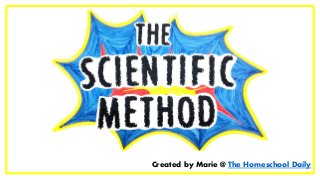
The Scientific Method
- 1. Created by Marie @ The Homeschool Daily
- 2. What is the Scientific Method? •A series of steps used to help solve a question or test a hypothesis.
- 3. What is the Scientific Method? 1) Ask a Question 2) Research Topic 3) Develop Hypothesis 4) Test Hypothesis 5) Record Data 6) Analyze Data 7) State Conclusion
- 4. Ask a Question • People ask questions everyday. • Why is it hotter in the summer? • Why don’t all balloons float? • A question may arise after making observations or it may be a question about a topic you are interested in. • Not all questions can be tested. 1st Step
- 5. Which one of these questions is based on opinion? A. Does my cat or dog eat more food? B. Does air temperature affect the chirping of crickets? C. Does water freeze faster in different containers? D. Which makes a better pet- cat or dog?
- 6. Which one of these questions is based on opinion? A. Does my cat or dog eat more food? B. Does air temperature affect the chirping of crickets? C. Does water freeze faster in different containers? D. Which makes a better pet- cat or dog? You can ask people what type of pet they prefer, but it is only based on opinion. The other 3 questions can be tested.
- 7. Research Topic • Gather information about your topic through research. • Read Books • Review Internet Resources • When possible, use your 5 senses to collect information about your topic. 2nd Step
- 8. Develop a Hypothesis3rd Step • A hypothesis is a possible explanation for a set of observations or answer to a scientific question. • Another term for hypothesis is ‘educated guess’.
- 9. Develop a Hypothesis • After doing your research, make a hypothesis to answer your question. • This is usually stated like, “If I…(do something) then…(this will occur)” • For example, “If I grow grass seeds in a sunny window, then they will grow faster than seeds growing in a shady window.” • Your hypothesis must be testable. 3rd Step
- 10. Before you can test your hypothesis, you must DESIGN your experiment and IDENTIFY: • Manipulated Variable (Independent variable): A variable that is changed. For example, the amount of light seeds are given. • Responding Variable (Dependent variable): A variable that changes in response to the manipulated variable. For example, the rate at which the seeds grow. • Controlled Variable: Variables that remain constant in an experiment. For example, the same seeds, amount of water, etc.
- 11. Test Hypothesis4th Step • This is the FUN part! EXPERIMENT TIME! • In this case, you would take two flat containers and plant the same amount of seeds in them. • You would water them the same. • The only difference is that one of the containers would be placed in a sunny window, while the other would be placed in a shady window.
- 12. Record Data5th Step • Data is facts, figures, and evidence collected in an experiment. • Collect data from your experiment. • The data gathered in your experiment is what will prove or disprove your hypothesis.
- 13. Analyze Data6th Step • Graphs, tables, charts, and statistics are used to organize the data collected. • Graphs reveal patterns or trends in data. • Graphs help others understand your data.
- 14. State Conclusion7th Step • Communicate your findings in a paper, poster, or oral presentation. • Was your hypothesis right or wrong? • Use the data you collected to prove or disprove your hypothesis. • It is not bad if your hypothesis is wrong, you learned something, right?
- 16. Check out our other learning resources at The Homeschool Daily! Timothy, guard what has been entrusted to your care. Turn away from godless chatter and the opposing ideas of what is falsely called knowledge, which some have professed and in so doing have departed from the faith. Grace be with you all. I Timothy 6: 20-21
